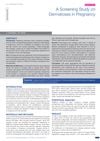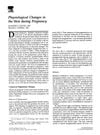TLDR Many pregnant women in Moradabad have skin changes and infections due to poor hygiene and nutrition.
The study conducted at a tertiary care center in Moradabad, India, observed skin lesions in 1,256 pregnant women out of 6,348 antenatal patients. It found that 40.4% had no complaints, while common conditions included hyperpigmentation (90.8%), linea nigra (94.6%), and striae (80.3%). Specific dermatoses of pregnancy were present in 8.68% of cases, with pruritus gravidarum (38.53%) and PUPPP (28.4%) being notable. The study highlighted a high prevalence of community-acquired infections like taenia (17.27%) and scabies (20.46%), suggesting links to poor hygiene, overcrowding, low socioeconomic status, anemia, and poor nutrition.
 81 citations
,
April 2009 in “Journal of Investigative Dermatology”
81 citations
,
April 2009 in “Journal of Investigative Dermatology” Hair shedding is an active process that could be targeted to treat hair loss.
 17 citations
,
March 2006 in “Journal of Cosmetic Dermatology”
17 citations
,
March 2006 in “Journal of Cosmetic Dermatology” Hormonal changes during and after pregnancy can cause hair growth changes and hair loss, with treatments available for some conditions.
 9 citations
,
January 2017 in “Journal of Clinical and Diagnostic Research”
9 citations
,
January 2017 in “Journal of Clinical and Diagnostic Research” Most pregnant women experience skin changes, mainly increased pigmentation, and some develop pregnancy-related skin conditions and infections.
 December 2023 in “International journal of research in dermatology”
December 2023 in “International journal of research in dermatology” Most pregnant women experience common skin changes like linea nigra and stretch marks.
 13 citations
,
June 1984 in “Postgraduate Medicine”
13 citations
,
June 1984 in “Postgraduate Medicine” Pregnancy can cause various skin changes, including pigmentation, acne, and stretch marks, and may affect preexisting skin conditions.
45 citations
,
January 2016 in “Journal of Epidemiology and Global Health” Most pregnant women experience skin changes, with hyperpigmentation being the most common.
 96 citations
,
January 1997 in “Clinics in Dermatology”
96 citations
,
January 1997 in “Clinics in Dermatology” Pregnancy can cause skin pigmentation, stretch marks, and changes in hair, nails, and sweat glands, with most resolving after birth.





